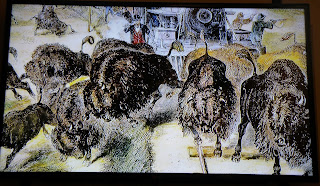I never realized
how much of a hub Lethbridge is - Highways 4, 3, and 5 all meet there
and travel off into different directions.
Highway 4 (extends
across the border from Interstate 15 in Montana) and led us to Writing-on-Stone; then we
travelled Highway 3 to the Head Smashed-in Buffalo Jump; and then onto Highway
5 to Cardston and the Remington Carriage Museum. So, all and all, we covered a fair amount
of Southern Alberta.
Cardston and the area around there, have a rather
interesting history. In the late 1880’s, Cardston became the first LDS (Mormon)
settlement in Canada. They say that the impetus to come north
from Utah and Montana was to escape the American laws against polygamy.
Polygamy was integral part of the Mormon religion and is still up-held by
certain extremist Mormon groups in North America.
The first Canadian Temple of the Church of Jesus Christ of
Latter-day Saints (Mormons) was completed within the first months of their
arrival (in 1887) at Cardston at the base of the Canadian Rocky Mountains.
The Kainai First Nation’s
(Blood Tribe) Reserve . . . one of the largest reserves in North America . . . stretches out to the north of the
community and the Canada-USA border is less than 25 miles to the south. To this
day, the Mormon Church wields a strong influence over the community.
The Remington Carriage Museum is a
park unto itself. It is situated on 20 acres on south end the Main
Street of
Cardston and covers over 64,000 square feet (5,900 m2 ).
We have been here before, but I think you
can go a dozen times and still not see it all.
Before you even get to the building itself,
the entrance offers a bronzed statue of the typical Western Cowboy:
(Taken
in 2002 with Fred and then this year)
Once inside the main building, there are
rooms and rooms and rooms of carriages, wagons and sleighs. The Museum has the
greatest collection of horse-drawn vehicles in North
America (over 300).
Many displays in the museum are set up to show the horses and wagons in their original settings.
others give us a glimpse of the travel mode
of the times:
And still others show the shop fronts needed to support the horse and buggy trade:
There are other incredible sites we tended
to brush over lightly . . . like . . . many of the video displays; the carriage
factory; the restoration shop, the stable; a carriage ride. And not least of
all the Carriage
Preservation Workshop where visitors can watch expert technicians carry out the
art of blacksmithing, wheelrighting, woodworking, metalworking and finishing.
BUT . . . darn it,
we just got tired!!
This is a
different way of touring and . . . well, maybe our maturity is catching
up with us!!
Our next challenge
was to do the Dinosaur Trail and the Royal Tyrrell Dinosaur Museum.

























